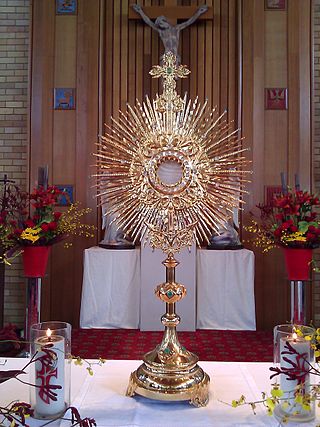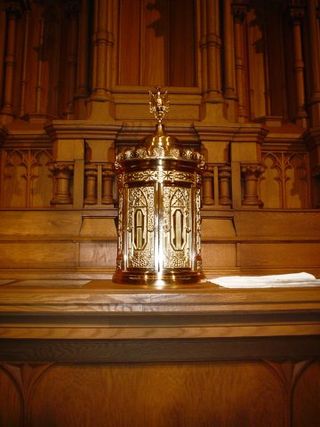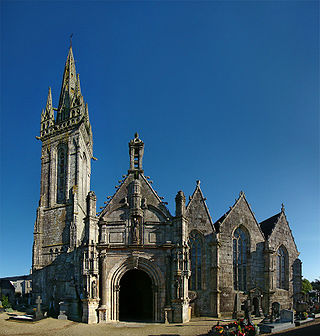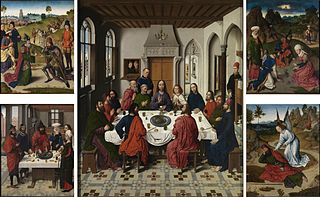
The Cathedral of St. Michael and St. Gudula, usually shortened to the Cathedral of St. Gudula or St. Gudula by locals, is a medieval Roman Catholic cathedral in central Brussels, Belgium. It is dedicated to Saint Michael and Saint Gudula, the patron saints of the City of Brussels, and is considered to be one of the finest examples of Brabantine Gothic architecture.

Eucharistic adoration is a devotional practice primarily in Western Catholicism and Western Rite Orthodoxy, but also to a lesser extent in certain Lutheran and Anglican traditions, in which the Blessed Sacrament is adored by the faithful. This practice may occur either when the Eucharist is exposed, or when it is not publicly viewable because it is reserved in a place such as a tabernacle.

A tabernacle or a sacrament house is a fixed, locked box in which the Eucharist is stored as part of the "reserved sacrament" rite. A container for the same purpose, which is set directly into a wall, is called an aumbry.

Dieric Bouts was an Early Netherlandish painter. Bouts may have studied under Rogier van der Weyden, and his work was influenced by van der Weyden and Jan van Eyck. He worked in Leuven from 1457 until his death in 1475.

Saint-Étienne-du-Mont is a church in Paris, France, on the Montagne Sainte-Geneviève in the 5th arrondissement, near the Panthéon. It contains the shrine of St. Geneviève, the patron saint of Paris. The church also contains the tombs of Blaise Pascal and Jean Racine. Jean-Paul Marat is buried in the church's cemetery.

The Metropolitan Cathedral of the Assumption of the Most Blessed Virgin Mary into Heaven, also commonly called the Mexico City Metropolitan Cathedral, is the cathedral church of the Catholic Archdiocese of Mexico. It is situated on top of the former Aztec sacred precinct near the Templo Mayor on the northern side of the Plaza de la Constitución (Zócalo) in the historic center of Mexico City. The cathedral was built in sections from 1573 to 1813 around the original church that was constructed soon after the Spanish conquest of Tenochtitlan, eventually replacing it entirely. Spanish architect Claudio de Arciniega planned the construction, drawing inspiration from Gothic cathedrals in Spain.

Vannes Cathedral is a Roman Catholic church dedicated to Saint Peter in Vannes, Brittany, France. The cathedral is the seat of the Bishop of Vannes.

Saint Peter's Church is a Roman Catholic church in Leuven, Belgium, built in the 15th century in the Brabantine Gothic style. The church has a cruciform floor plan and a low bell tower that has never been completed. It is 93 metres (305 ft) long. It is located on the city's Grote Markt, opposite the Town Hall. In 1999, the belfry and bell tower of the church was inscribed on the UNESCO World Heritage List as part of the Belfries of Belgium and France site, in recognition of the civil importance and architecture of the belfries in the region.

The altar in the Catholic Church is used for celebrating the Sacrifice of the Mass.

La Santísima Church is located 12 La Santísima Street at corner of Emiliano Zapata Street in the historic center of Mexico City. Its full name is Church and Hospital of the Most Holy Trinity. The church was built between 1755 and 1783 as a temple for the adjoining hospital/hospice for priests. The hospital functioned until 1859, when the Reform Laws nationalized much of Church's property in Mexico. The church still retains its original function but the adjoining hospital and office sites have since moved into private hands with only parts of the original structures still intact and preserved.

The Church of St. James on Coudenberg is a Roman Catholic church located on the historic Place Royale/Koningsplein, in the Royal Quarter of Brussels, Belgium. It is dedicated to Saint James, one of the Twelve Apostles of Jesus.

The Co-Cathedral of Saint Nicholas in Prešov is one of the oldest and most important churches in Slovakia. The external dimensions of the cathedral are 54.7m in length and 34.45m in width. The indoor nave is 16 m tall and the tower reaches a height of 71 meters. The temple's design takes inspiration from the Late Gothic hall churches with three naves.

The Abbey of Santa Giustina is a 10th-century Benedictine abbey complex located in front of the Prato della Valle in central Padua, region of Veneto, Italy. Adjacent to the former monastery is the basilica church of Santa Giustina, initially built in the 6th century, but whose present form derives from a 17th-century reconstruction.

St. Paul's Church is a Roman Catholic church located at the Veemarkt in Antwerp, Belgium. Its exterior is mainly Gothic with a Baroque tower while the interior is characterised by its rich Baroque decoration. It holds paintings by Antwerp's leading artists Peter Paul Rubens, Anthony van Dyck and Jacob Jordaens as well as abundant sculpture and church furniture crafted by leading Antwerp sculptors such as Artus Quellinus the Elder, Pieter Verbrugghen I, Jan Pieter van Baurscheit de Elder, Jan Claudius de Cock and Andries Colyns de Nole. Of particular note is the Calvary outside the Church which is made up of 63 life-size statues and nine reliefs executed in a popular and theatrical style.

The Saint-Herbot Parish close is a religious complex outside the village Plonévez-du-Faou, Finistère, Brittany in north-western France. It is located on the road between Huelgoat and Loqueffret. The parish close contains the chapel of Saint-Herbot, the calvary and a small ossuary.

The Bodilis Parish close of Bodilis is located in the arrondissement of Morlaix in Finistère department of Brittany in north-western France. Apart from the parish church, the Église Notre-Dame, the enclosure at Bodilis includes a perimeter wall with three entrance gates and a simple crucifixion cross. The ossuary was destroyed in 1825. The church is a listed historical monument since 1910. The choir and central nave date to 1567 and the bell tower was added in 1570. The porch was added in 1601 and the sacristy in 1682. From the beginning of the 16th century, Bodilis' burgeoning linen industry boosted the town's wealth. An important fair was staged there and there were frequent pilgrimages to the town to secure "pardons" from the Virgin Mary. Much of the wealth generated was channeled into enhancing the parish church and, as a result, it shows elements of Gothic, Renaissance, Classical and Baroque styles. The bell tower porch is of the late Gothic style and is forty metres high. The church also has a 1564 chevet built in the Beaumanoir style.

The Locmélar Parish close is located at Locmélar in the arrondissement of Morlaix in Brittany in north-western France. It is a listed historical monument since 1934.

Altarpiece of the Holy Sacrament or Triptych of the Last Supper is a 1464–1468 dated folding triptych with at least five panel paintings attributed to the Flemish painter Dieric Bouts, now reassembled and held at its location of origin in the eastern choir chapel of St. Peter's Church, Leuven, Belgium.

Saint Quentin's Church is a Roman Catholic church located at the Naamsestraat in Leuven, Belgium. Its exterior is mainly Gothic with a Baroque entrance portal. The interior contains Baroque choir stalls and altars. The church is named after the Saint Quentin, who is regarded in the Catholic faith as a protector against a wide range of contagious diseases.

The Martyrdom of Saint Erasmus is a triptych panel painting by the Flemish painter Dieric Bouts in the collegiate church of Saint Peter's in Leuven, Belgium. It commemorates the martyrdom and death of a European Christian figure from the fourth century, Saint Erasmus. It shows the Emperor Diocletian as one of four observers in the background of the center panel, as well as Saints Jerome and Bernard of Clairvaux in the wings of the altarpiece. All nine figures appear to express an exceptional tranquility and calm, in a landscape setting that is contiguous across the three panels.




















